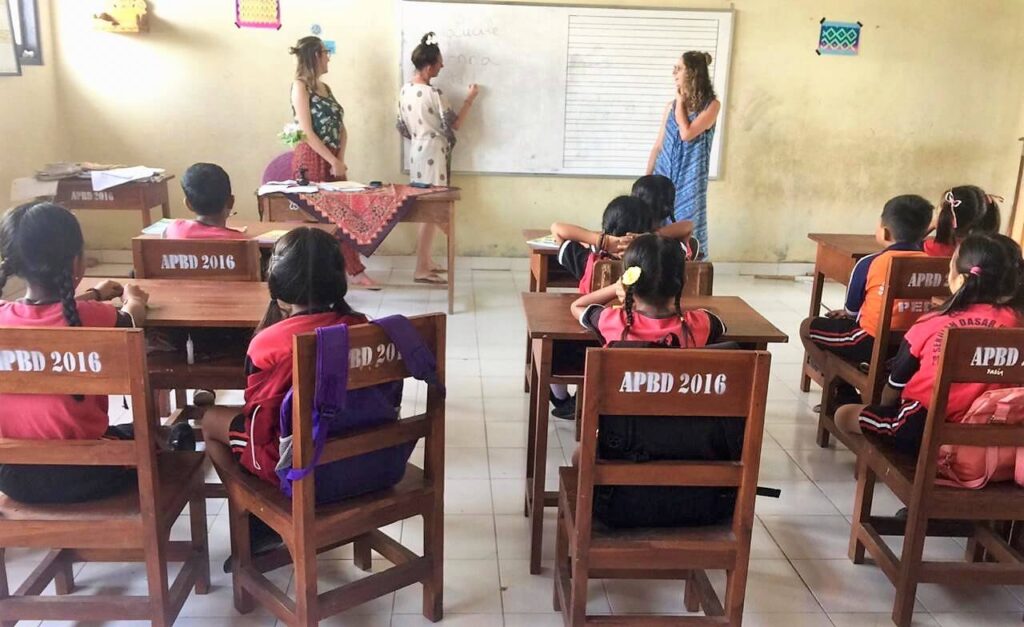If you find yourself teaching English in a setting with limited classroom equipment and other teaching resources, don’t worry! As a teacher who’s been there, I know there are plenty of ways to work around what might, at first, seem like limitations. For instance, you can diversify your teaching strategies, focus on students’ conversational skills, or find free ESL resources online. Plus, teaching with limited resources can even help you become a more creative, adaptable teacher.
Take a Micro-credential Certification Course in Teaching English With Low Resources to explore innovative ideas for inspring your students and designing lessons with limited access to teaching materials.
What does it mean to teach English with limited resources?
There are many types of teaching resources that can enhance your instruction or help you deliver an especially engaging lesson. Some examples of resources that are typically available to English teachers include:
You may find yourself without these resources entirely, or you might wind up in a situation where they’re in limited supply or don’t function properly. You could also have access to these resources only part of the time.
Other types of resource limitations
Teaching resources aren’t just restricted to technology and equipment. Other types of resource limitations could include a lack of adequate classroom space or not having a teaching assistant, aide, or other support. Essentially, teaching with limited resources simply means that you don’t have access to the diverse tools or means that many schools typically provide in order to strengthen your teaching.

Carol Duster with some of her Cambodian school’s students
Who is teaching English with limited resources?
Teaching location, lack of funding, and other, unexpected circumstances are a few of the factors that can result in teachers entering the classroom without adequate resources.
Teachers in developing or rural areas
You might teach English with limited resources if you work in locations that are developing or if you teach in rural or small towns. Schools in these locations may have less funding available for resources or there simply may not be services in the town that support technology like Wi-Fi.
Teachers in other situations
Some teachers have access to the resources and materials they need but find that those materials are inappropriate for the age or level of the students they’re teaching. In fact, any teacher can end up teaching with limited resources because no matter where in the world you teach or how much funding your school has, the situation may arise when your equipment stops functioning in the middle of a lesson or you find yourself subbing last-minute for a class for which you haven’t prepared. Whatever your current teaching circumstances, it’s a valuable skill to be able to teach with sparse resources!
In a teaching bind? Try out these last-minute lesson plans that can be adapted for any class!

Lessons with ESL school kids in Indonesia
Can you effectively teach without a lot of resources?
The answer is yes! In fact, in some cases, there may even be certain advantages to teaching English with limited resources.
For example, teaching without resources can force you to become a better, more creative teacher. You’ll have to think outside the box when it comes to planning activities, which can sometimes result in really interesting ESL lessons that your students would never have gotten to experience otherwise.
Teaching without resources such as textbooks or a pre-designed curriculum, or even teaching without a ton of support from the school, can all translate to you having more flexibility and autonomy with your students. Look at it as an opportunity to explore lessons and topics that aren’t normally included in a curriculum. You can try out new ESL teaching methods and really cater lessons to your students’ interests and English level.
What are some tips for teaching English with limited resources?
There are many things you can do to combat a lack of resources. Here are some easy teaching tactics that you can implement right away!
If you’re new to teaching, you’ll want to get initial training and qualification with a TEFL certificate. You can explore our online TEFL courses to get started!
Change up your teaching strategies
Certain teaching strategies work better than others when it comes to delivering effective lessons with limited resources. For example, if you only have a certain number of supplies or textbooks, try grouping students together during the lesson. Having them work together not only solves the problem of not having enough materials but also promotes teamwork and offers valuable English speaking opportunities.
Another teaching strategy that may work to your advantage when you have to teach ESL with no resources is to incorporate realia into your lessons. While you may not have the opportunity to print worksheets, draw pictures on a whiteboard, or use textbooks, you can always bring in objects from home. Use the free and readily-available materials you already have around you to inspire your lesson plans.
Learn more about using realia to teach ESL.
Incorporate lots of games and activities
Using no-prep ESL activities and games is a great way to reinforce a lesson without needing any supplemental materials. There are tons of activities that don’t require anything more than you and your students. Examples include games like “Simon Says,” “Telephone Race,” and “Two Truths and a Lie.” These activities are not only effective for getting students to practice their English but are super fun for young learners and teens!
Focus on speaking skills
Most schools that prescribe to the communicative language teaching approach prioritize English speaking skills and are less concerned with things like grammar. Fortunately, speaking is one area that’s easy to focus on without incorporating additional materials or technology. If you find yourself having to teach English with limited resources, consider embracing the communicative teaching method and focusing on getting students to speak through role-play activities, debates, or games.
Discover more TEFL speaking activities.

A teacher with her students in Vietnam
Where can you find free resources for your class?
There are plenty of free ESL lesson plans out there! Some sites with good options include BusyTeacher and iSLCollective. These sites offer lesson plans, worksheets, activity ideas, and more. If the school where you’re teaching doesn’t have a curriculum in place, you can easily search online to get ideas when planning your lessons and deciding what you’re going to cover for the school year.
And, the great thing about using these free online resources is that you can adapt them to nearly any situation. For example, if you don’t have access to a printer, simply adapt the worksheets you find online by drawing easy versions of them on your whiteboard and having students write their answers down on notebook paper. Likewise, if the free lesson plan you found online includes audio but you don’t have any technology in your classroom, print out the transcript and read it to the students yourself. No matter what limitations you’re facing, you can always adapt lesson plans and activities to fit your needs.
My experience teaching English with limited resources
Having taught in Colombia since 2018, I know a bit about teaching English with limited resources when it comes to being in a developing country. Honestly, though, having limited resources while teaching has provided me with countless opportunities to create my own curricula and design exciting lesson plans. For example, I have a degree in literature and have been able to incorporate some of my favorite classic novels and literary training into the ESL classroom because the school has allowed me the flexibility to create my own programs. (Read more about my experience teaching abroad.)
And, while I initially thought it would be difficult to teach English with limited resources, I soon discovered there’s a way around nearly anything. No whiteboard? Tape some posterboard to the wall and invest in a good Sharpie. No English books? Download a digital copy onto your Kindle and read aloud to the class. No printer? Turn the activity into a dictation and have students write down what would’ve been on the worksheet.
In other words, no matter where you’re teaching or what resources you have — or don’t have! — you can still help your students excel in English and have a great time in the classroom.










